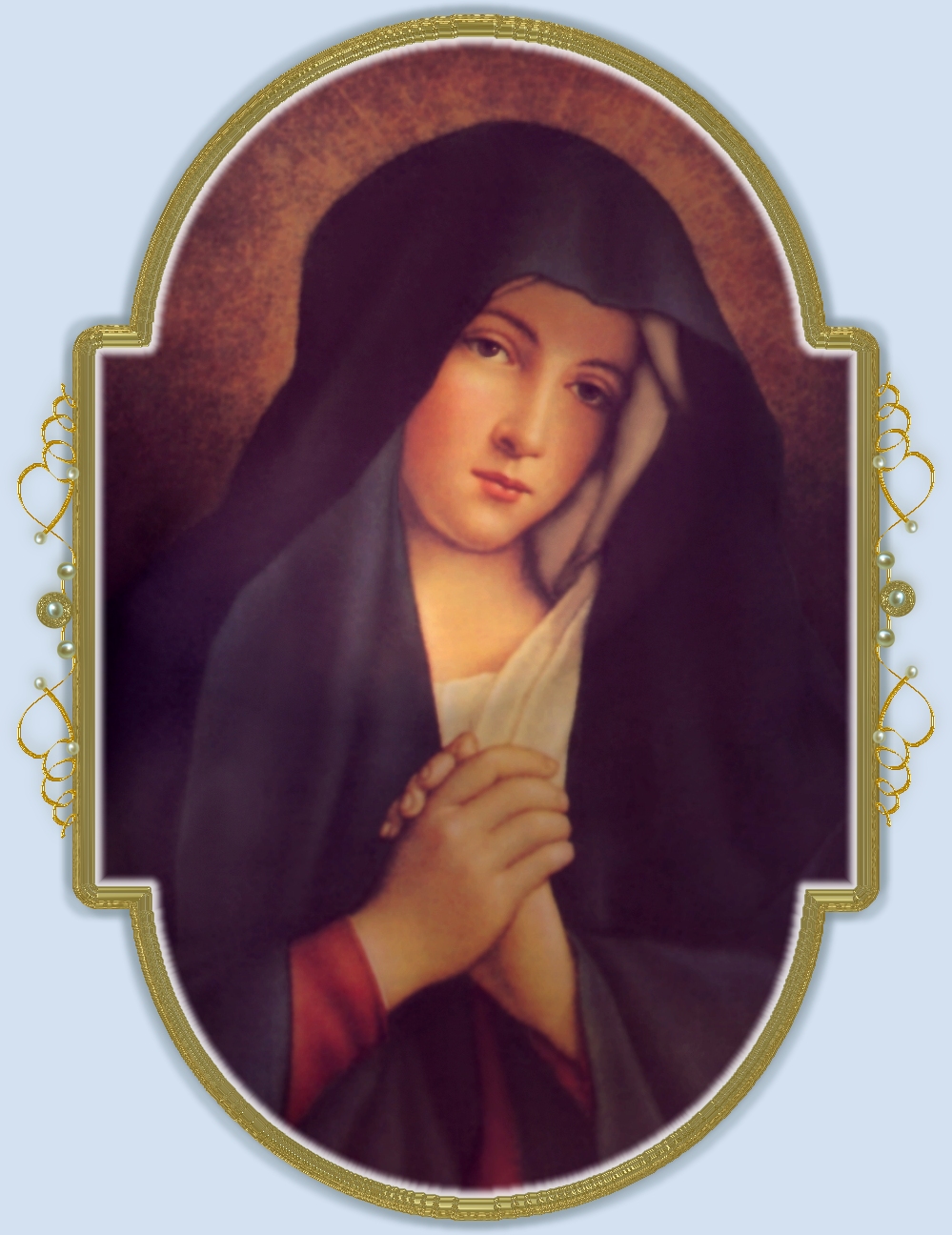Introduction
The purpose of the Devotion of the
Seven
Sorrows
is to promote union with the sufferings of Christ through union with
the
special suffering that Our Lady endured because she was the Mother of
God.
By uniting ourselves with both the Passion of Christ and His holy
Mother,
we enter into Jesus' Heart and honor Him greatly; He is more honored
because
we have so honored His Mother.
The Seven Dolors are taken from
Scripture
events and the devotion has a long history, although it was not
officially
promulgated by the Church until the early nineteenth century. Before
Pope
Pius VII's formal approval, the Servite Order had permission in 1668 to
celebrate the Feast of the Seven Dolors because the Order was
instrumental
in popularizing the Seven Sorrows Devotion.
In the Middle Ages,
Catholic theology concentrated mostly on Christ's Passion; at the side
of the Man of Sorrows, however, the faithful always contemplated the
Queen
of Martyrs. Devotion to the Crucified Christ and to Our Lady of sorrows
grew side by side. On Calvary there were in a sense two altars, one in
the Body of Jesus, and the other in the Immaculate Heart. Christ
immolated
His flesh, Mary, her heart, her own soul. On September 15, the day
following
the ancient feast of the Holy Cross, the Church commemorates the
compassion
of Mary; but it is fitting during the year, especially during Lent, to
honor the Sorrows of Mary.
Mary is not mentioned
in the Gospel accounts of Christ's Transfiguration, His entry into
Jerusalem,
but she is recorded as being present at Calvary. She understood what
the
Will of God was and was faithful, co-operating with her Son as
Co-redemptrix.
She had prepared the victim for sacrifice and now she offered Him on
the
altar of Calvary.
The Gospel, John 19:25,
says: "Near the Cross of Jesus stood His mother, his mother's sister,
Mary,
the wife of Cleopas, and Mary Magdalene." At Christ's bequest, Mary was
proclaimed the universal Mother of mankind from the Cross.
Mary had three loves
in her Immaculate Heart: God, her Son, and souls. She so loved the
world
that she gave her only Son. As St. Bernard said, "The sword would not
have
reached Jesus if it had not pierced Mary's heart." Mary loved souls and
on Calvary, after suffering such cruel torments she merited being the
mother
of all mankind.
Mary is the Apostle
because she is Co-redemptrix: Behold Mary on Calvary, she suffers and
prays;
she stands, as one offering sacrifice.
St. Ambrose said, "I
read that she stood, but I do not read that she wept." When Mary gave
us
her Son, she gave us everything. Therefore it can very well be said:
"Behold
this heart which has so greatly loved all people that it has spared
nothing
for them."
The Seven Graces of this Devotion
1. I will grant peace to their
families.
2.They will be enlightened about the
Divine mysteries.
3. I will console them in their pains
and I will accompany them in their work.
4. I will give them as much as they
ask for as long as it does not oppose the adorable will of my Divine
Son
or the sanctification of their souls.
5. I will defend them in their
spiritual
battles with the infernal enemy and I will protect them at every
instant
of their lives.
6. I will visibly help them at the
moment of their death, they will see the face of their Mother.
7. I have obtained this Grace from
my Divine Son, that those who propagate this devotion to my tears and
dolors,
will be taken directly from this earthly life to eternal happiness
since
all their sins will be forgiven and my Son and I will be their eternal
consolation and joy.
Benefits of the
Devotion to the Mother of Sorrows
1. To realize the value
of a soul, worth the supreme Sacrifice on Calvary.
2. To work for souls,
by evangelization, duty to life's duties, and
prayer for sinners.
3. To pray always,
in a life of union with God; whoever has a heart similar to Jesus' and
Mary's hearts, will work for the salvation of souls.
When we commit sin we
bring sorrow to Our Lady, for she is, indeed
our very Mother, our
spiritual Mother, and she watches over
us as she watched over
her Baby, nearly two thousand years ago.
It is the desire of
Jesus that we should think of His Passion, to offer Him
our devotion and to
renew our sorrow for sin. It is also His desire,
as the Church makes
clear to us, that we should think of the
compassion of Mary
in His Passion.
The Mass for the Feast of the Seven Dolors
includes the traditional hymn, the Stabat Mater, which is
traditionally
included by verses in the 14 Stations of the Cross. St. Bonaventure is
considered the author of the Hymn. We present it below in its entirety
both in Latin and in English. At the conclusion of the 7th Sorrow you
will
find two prayers to Our Lady of Sorrows, one by St.
Bonaventure and one by St. Alphonse
Liguori.






